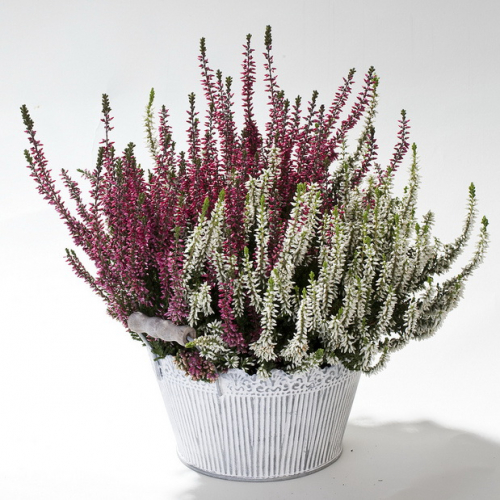Indoor plants Calluna

Description
Special Features of Heather
Heather (or more precisely Common Feather or Calluna vulgaris), belongs to the genus Heather that falls into the heath family Ericaceae. There are over 120 other genera in the family, with more than 4,000 species in total. Heather, though referred to as common, is the sole species in the genus. Its distribution is limited to the Northern Hemisphere, mostly its upper segment:
- Europe (including European Nonblack Soil Zone in the former USSR),
- Asia (West and East Siberia),
- North America (Atlantic Coast and Greenland, the largest island in the world).
It would be wrong to say that Heather is a strictly cold-loving plant, for it is found in North Africa and the Azores where summers are hot enough. (On a different note, during the reign of Nicholas II, the Russian Empire was offered to buy some of these islands, small but value-priced. The Emperor listened to the officials from the Naval Headquarters and declined the offer because the officials did not see a possibility to build coaling places on the islands with for the ocean-going fleet. Nobody thought about year-round resorts and eco-tourism.)
Calluna vulgaris is a low-growing evergreen perennial branching shrub 20-80 centimetres tall, with tiny three-edged needle-like leaves. The flowers are also small (about 2-3 millimetres across) but profuse, collected in thick spikes up to 25 centimetres long. They appear in July and August and delight the eye with their mauve colouring.
Currently, there are a few dozen cultivars varying in colour of flowers and foliage. For example, variety Silver Knight has silvery grey leaves in the summer; varieties Aurea, Boskoop, Con Brio, Golden Starlet, and Gold Haze have yellow leaves; usual foliage colour in the winter is dark green but Aurea has red-brown and Boskoop copper leaves. Though the plant blooms from June to August, it also looks great in the autumn and winter too. Heather prefers cool bright locations and will brighten dull grey days with its modest but charming splendour, if placed in the glazed balcony.
It should be noted that Heather is perfect for ground cover and Alpine rock gardens.
The Secrets to Successfully Growing Heather
Heather grows better in well-lit areas with some protection from direct sunlight. It can grow in light shade but, firstly, flowering will not be as profuse and luxurious, and secondly, foliage colour will not be so bright.
The Heather root system is shallow. If grown in sandy soils, where moisture easily and quickly goes from the upper layers to the bottom, the plant may suffer from a lack of moisture. Water regularly. Do not loose the soil deep after watering or while removing weeds. Place the pot on a tray with damp moss, sand, or expanded clay.
Heather is sensitive to ambient humidity and it does not tolerate dry air. Mist regularly, especially in the summer. Mist in the evening (daily) to prevent burning by sunlight focused in water drops like small lenses.
The best temperature ranges from 18 to 20 ° C in the summer and from 7 to 12 ° C in the winter.
Heather needs annual feeding with mineral fertilizer. Feed the plant in the spring very carefully, preventing fertilizer from getting on the leaves or flowers as they can get burnt.
Heather as well as all potted plants of the Ericaceae family does not like repotting. Choose an adequate-sized pot allowing for future growth.
In the wild, Heather reproduces mainly from seed. Growers have learned to use vegetative propagation by using cuttings or dividing the shrub. It is believed that the latter method provides better results.
Divide the shrub in the spring from mid-April to early May or in the autumn in late September to early October. Plant the shrubs 30-40 centimetre apart and 30 centimetres deep so that the root collar is right at the ground level. After planting, water well.
Heather needs pruning because without it, it ages faster and loses shape. There are, however, cushion-like varieties that do not require pruning. In April, prune the last year's shoots by 50%. Be aware, however, that severe pruning is not advisable in the first two years after planting, so prune less than by half.
Potential Problems
Heather has earned a good reputation not only for its winter hardiness but also for its perfect ability to ignore pests and diseases. However, sometimes under unfavourable conditions (high humidity of air and soil), diseases like grey mold, powdery mildew or rust ("wheat leaf rust") can develop. Be alert and respond promptly to control the diseases.







 1 096
1 096








